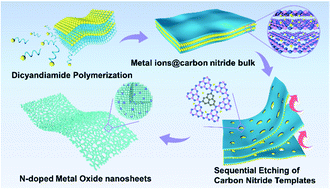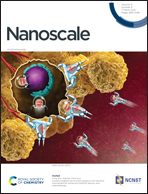Two-dimensional quasi-nanosheets enabled by coordination-driving deposition and sequential etching†
Abstract
Transition-metal compounds are attractive for catalysis and other fields but generally suffer from aggregating propensity, circuitous diffusion pathways and limited reaction activities. Two-dimensional (2D) quasi-nanosheets composed of nano-sized crystals with precisely controlled stoichiometric features can readily overcome these problems. We here construct a variety of interconnected 2D holey arrays composed of single-crystal nitrogen-doped nanoparticles through a coordination-driving deposition and sequential etching (CDSE) strategy, independent of the phases and stoichiometries of target crystals. The strong coordination between the empty orbits of metal ions and n-orbits of pyridine nitrogen in conjugated carbon nitride (CN) confines the growth of metal species in 2D form. Meanwhile, the eighteen-membered-rings of CN coupled with metal ions can be thermally etched preferentially as a result of weakened N![[double bond, length as m-dash]](https://www.rsc.org/images/entities/char_e001.gif) C bonds caused by forming the TiO2+-N6 configuration. The as-obtained metal oxide quasi-nanosheets and their phosphatized counterparts show impressive activities in photocatalysis and electrocatalysis owing to the synergetic effect of geometric and compositional features. Our CDSE strategy offers a versatile platform, with which to explore the properties and functions of hierarchical architectures.
C bonds caused by forming the TiO2+-N6 configuration. The as-obtained metal oxide quasi-nanosheets and their phosphatized counterparts show impressive activities in photocatalysis and electrocatalysis owing to the synergetic effect of geometric and compositional features. Our CDSE strategy offers a versatile platform, with which to explore the properties and functions of hierarchical architectures.



 Please wait while we load your content...
Please wait while we load your content...